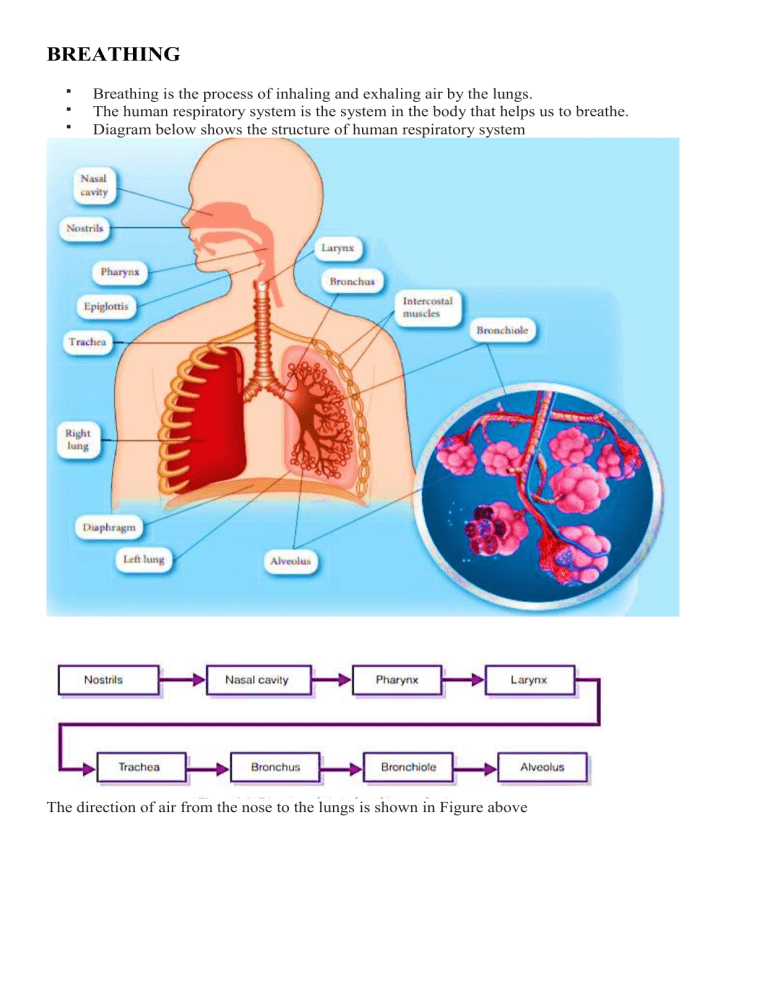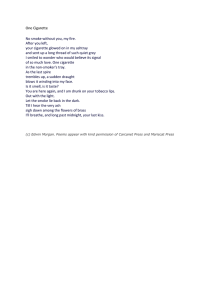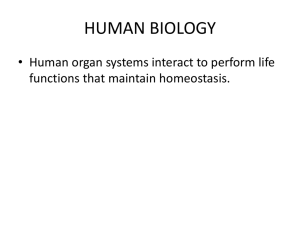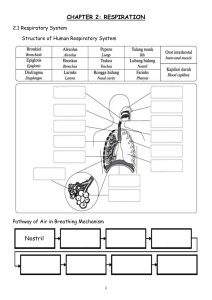
BREATHING Breathing is the process of inhaling and exhaling air by the lungs. The human respiratory system is the system in the body that helps us to breathe. Diagram below shows the structure of human respiratory system Breathing Mechanism The direction of air from the nose to the lungs is shown in Figure above Inhalation When you inhale, Intercostal muscles contract and pull the rib cage upwards and outwards as shown in diagram above. Diaphragm muscles contract and pull the diaphragm to descend and become flat. Movements of the rib cage and diaphragm make the thoracic cavity bigger and cause air pressure in the thoracic cavity to decrease. The higher air pressure outside forces air to enter the lungs as shown in diagram (b). When you exhale, Intercostal muscles relax and the rib cage moves downwards and inwards as shown in diagram above. Diaphragm muscles relax and curve upwards. Movements of the rib cage and diaphragm make the thoracic cavity smaller and cause the air pressure in the thoracic cavity to increase. The higher air pressure in the lungs pushes the air out as shown in diagram (b). Movement and Exchange of Oxygen and Carbon Dioxide in the Human Body The air inhaled into the alveolus has a higher concentration of oxygen compared to the concentration of oxygen in the blood. Therefore, oxygen will diffuse through the wall of the alveolus into the walls of the capillaries and into the blood. In red blood cells, there is a dark red-coloured compound known as haemoglobin. Haemoglobin will combine with oxygen to form oxyhaemoglobin which is an unstable compound and bright red in color. Haemoglobin + oxygen <--------> Oxyhaemoglobin Blood with oxyhaemoglobin is transported from the lungs to the heart and pumped to the other parts of the body. When the blood reaches the area around the body cells that has a low concentration of oxygen, the oxyhaemoglobin being an unstable compound will decompose to release oxygen molecules and change back into haemoglobin. In the body cells, the diffused oxygen oxidises glucose molecules into carbon dioxide, water and energy through the process of cellular respiration as summarised in the following chemical equation. Glucose + oxygen → carbon dioxide + water + energy Carbon dioxide released by the cells diffuses into the blood capillaries and is transported to the alveolus to be removed during exhalation. Importance of the Adaptations of the Alveolar Structure The adaptations of the alveolar structure increase the efficiency and maximize the exchange of gases in the human body. The adaptations of the alveolar structure are :1. Thickness of the walls of alveolus and blood capillaries. 2. Moist wall of alveolus. 3. Surface area of alveolus. 4. Network of capillaries covering the alveolus. Substances that are Harmful to the Human Respiratory System Cigarette tar Cigarette tar is one of the toxic substances found in cigarette smoke. Cigarette tar in inhaled air sticks to and kills cells in the air passage such as the thorax, pharynx, epiglottis, larynx, bronchi, bronchioles and alveoli. Cigarette tar also increases the production of mucus and phlegm in the lungs. Cigarette tar is an example of a substance in cigarette smoke that can cause lung cancer. Carbon monoxide Carbon monoxide is usually found in cigarette smoke and exhaust gases of motor vehicles. Carbon monoxide is a colourless and odourless gas. When carbon monoxide diffuses from the alveoli into the blood capillaries, it will combine chemically with haemoglobin to form carboxyhaemoglobin which is a stable compound. This causes a shortage of oxyhaemoglobin in blood that transports oxygen to the body cells. Due to this shortage, the body cells are unable to produce the required amount of energy through cellular respiration. Nitrogen dioxide Nitrogen dioxide that is released into the air is normally produced by the combustion of fuels such as petrol and diesel in motor vehicles. Nitrogen dioxide is a brown-coloured gas with a pungent smell. This gas irritates the air passage and causes cough, difficulty in breathing and asthma. Sulphur dioxide Sulphur dioxide that is released into the air is normally produced by the combustion of coal from power stations. Sulphur dioxide is a colourless gas with a pungent smell. It irritates the air passage causing cough, difficulty in breathing, bronchitis and lung cancer. Haze, dust and pollen Haze, dust and pollen are solid particles which are fine, light and suspended in the air. The smoke from motor vehicle exhaust, open burning and forest fires produces haze and dust. Pollen released from anthers into the air is carried by the wind over long distances in all directions. Haze, dust and pollen irritate the respiratory system and cause respiratory diseases such as asthma Re Respiratory Diseases and their Symptoms Asthma Asthma is triggered by the presence of dust, pollen, haze, and smoke from cigarette and motor vehicle exhaust, open burning and forest fires. Symptoms of asthma include shortness of breath, wheezing and coughing. Bronchitis Bronchitis is an inflammation of the bronchus caused by tar and irritants in cigarette smoke. Symptoms of bronchitis include shortness of breath, persistent coughing and insomnia. Emphysema Emphysema is the condition of the alveoli in the lungs which are damaged by harmful substances in the air such as irritants in cigarette smoke. Symptoms of emphysema include shortness of breath, pain when breathing and feeling tired from doing even a light task. Emphysema patients cannot be cured but the symptoms of this disease can be controlled. Lung cancer Lung cancer is caused by cancer causing chemical substances known as carcinogens. These chemical substances are inhaled during breathing. Cigarette smoke contains various carcinogens, for example tar that causes lung cancer. Symptoms of lung cancer include persistent coughing, blood in the phlegm and feeling pain when breathing. Observe the difference between healthy lungs and the lungs of a cancer patient shown in photograph below.



